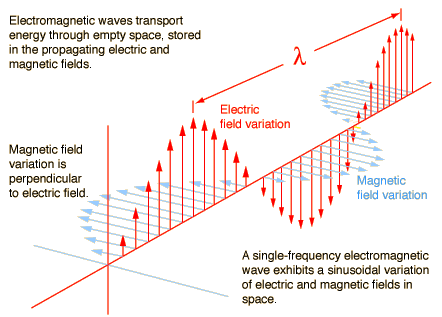Maxwell’s Equations and EM-light Theory
In 1801, an experiment done by English Physicist Thomas Young, named the Double-Slit Experiment, indicated that light exhibited properties known to be wavelike, contrary to Newton's belief of light being a particle. The light interfered with itself, as if it were a wave, and so was determined by the scientific community of the time to be a kind of wave. The two light sources produce the interference patterns familiar to anyone who has thrown two pebbles into a calm pond, as some points amplify to be larger peaks or troughs, while other places cancel out to still water.

Electromagnetic Waves
Electromagnetic waves transport energy through empty space, stored in the propagating electric and magnetic fields.
The magnetic field is perpendicular to the electric field.
A single-frequency electromagnetic wave exhibits a sinusoidal variation of the electric and magnetic fields in space.
http://web2.uwindsor.ca, “Photon visual”

Maxwell's Derivation of EM-Waves
In the 1860’s, James Clerk Maxwell formulated his equations of electromagnetism. These equations, describing the relationship between the electric field and magnetic field, described of a transverse (90° to the direction of propagation) wave between the two fields that almost perfectly matched the speed of light. Solutions to these equations also produced that the speed of light should be a constant called the speed of light (c, in a vacuum). This idea will become important later on.
Proof of the constant speed of light, as provided by James Clerk Maxwell
These findings led to 2 very interesting questions:
How can the speed of light be constant if, by a Galilean transform, its speed can be increased? (Newtonian Relativity)
Since light had been determined to be a wave and could travel through a vacuum (a region of space without matter), does that mean there's a medium that light propagates through? (Since sound waves require a medium, the logic follows, light must have one as well).
The most widely accepted theoretical medium for light at the time was a so-called Luminiferous (light-bearing) Ether.